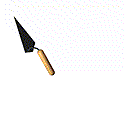'TWAS THE YEAR 1997 AT DhRl
16.....
THE SITE
If you paid attention, you
probably noticed that we
skipped the year 1996. Once
again, there was not enough
money to run an excavation
so the year was spent
studying what we had learned
so far.
Hold on to your seat though
because
1997 was a busy year at
DhRl 16 !
This year we had a crew
of over thirty people, so we got
a lot done, but the going
was tough.
The mosquitos were out in
full force this season,
so everyone on the site
was continually doing battle with the bugs.
As you know, DhRl 16 has
been worked on for several seasons.
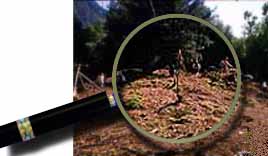 Several different excavations
have gone on, let's just go over them once more to get them straight.
Several different excavations
have gone on, let's just go over them once more to get them straight.
-
In 1992 we excavated two burial
mounds
-
In 1993 we excavated a trench and
found house floors
-
In 1995 we continued to excavate
this trench and found house floors layered one on top of another
With all this excavation,
you might expect that the site would
look very messy, with trenches
and holes everywhere.
Surprisingly, it doesn't.
It's almost hard to imagine that so much
work has been done on the
site when you first look
at it at the beginning of
a season.
This is because the
grass and trees grow back so fast that they cover
up most of our traces from
the past years. If you look carefully
though, like a good archaeological
detective, you will probably
see markers and other things
stuck in the ground that can give us
clues as to where an excavated
area is.
WHAT DO WE ALREADY KNOW?
From past years excavations
we know that DhRl 16 has burials
and house floors. Last season
we found out that the
houses were built one on
top of another.
If you think about it that's
quite a lot of information that we now know.
Although it took a few years,
it's a big leap compared to what
we knew before we started!
WHAT DO WE WANT TO KNOW?
Because we had such a big
crew this year, we decided to focus
our research on several
things at DhRl 16.
Our main goal was to expand
on our findings from earlier
years and to make sure that
they were correct.
In order to do this, we
asked a few different questions:
1. We wanted to find out about what the houses that
stood at the site looked like.
How big were they? What went on inside of them?
2. We also wanted to know why the houses were built so
close to the mounds. What was the relationship between
the two things?
3. Lastly, we wanted to know if this site was related to other
ones in the area or if there was other archaeological remains
in the mountains and area nearby.
WHAT DID WE DO?
1. To find out more about the houses, we exposed large
sections of the house floors that we had found by very
carefully excavating away the top of the soil until we
reached the floor. We also took samples so
we could identify what animals and plants were there
at the time the houses stood.
2. To find out more about how the houses related to the
burial mounds, we dug some 'test' excavation pits.
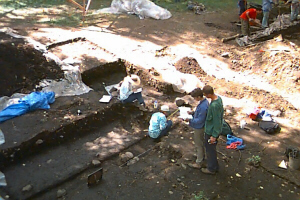
3. In order to find out more information about the area
near the site, one of our archaeologists went trekking in
the mountains and the area all around the site looking for
other archaeological remains and clues.
WHAT
DID WE FIND?
Wow! We found out tons of
stuff !!!
1. By looking
at the house floors carefully in the area excavated
we found over fifty artifacts like stone tools. We also found some
features, like a hearth and a posthole (where a log that supported the
house once stood).
2. Our test pits that we
excavated made us think that possibly, the houses were sometimes built
over mounds and mounds were
sometimes built over houses. Because the site is so old, it probably
changed a lot over time when people were using it. This is not
surprising. Some of the houses that you and I live on are built
on top
of old cemeteries. This is because cemeteries
take up a lot of space and
they don't last forever.
3. The archaeologist who
went looking for other archaeological remains in
the area nearby found a lot of neat things. She found over 75 more
burial mounds !
It's amazing to think about
how much stuff is out there that we still don't know about !
WHY DON'T YOU CHECK OUT
THIS YEAR'S ACTIVITY
PAGE??
LEARN ALL ABOUT FLOATATION
BY
DOING IT YOURSELF!!!
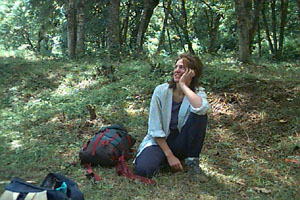 This season was pretty amazing.
Can you imagine yourself
out there in the forest by the rivers, excavating the house floors, digging
test pits, climbing up mountains looking for clues?
It's neat to think about
these things.
It would be hard work but
so much fun !!
This season was pretty amazing.
Can you imagine yourself
out there in the forest by the rivers, excavating the house floors, digging
test pits, climbing up mountains looking for clues?
It's neat to think about
these things.
It would be hard work but
so much fun !!
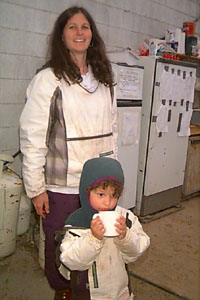 This year at DhRl 16 we
found out so many things. The funny thing is that, because of all this
new information, we now have many
more questions to ask.
This is the cool thing about
archaeology..
It's a lot like homework
in that it is just never quite done !
Hmm... this brings us to
1998. I wonder what
they are doing...
TAKE
ME TO 1998!
This year at DhRl 16 we
found out so many things. The funny thing is that, because of all this
new information, we now have many
more questions to ask.
This is the cool thing about
archaeology..
It's a lot like homework
in that it is just never quite done !
Hmm... this brings us to
1998. I wonder what
they are doing...
TAKE
ME TO 1998!